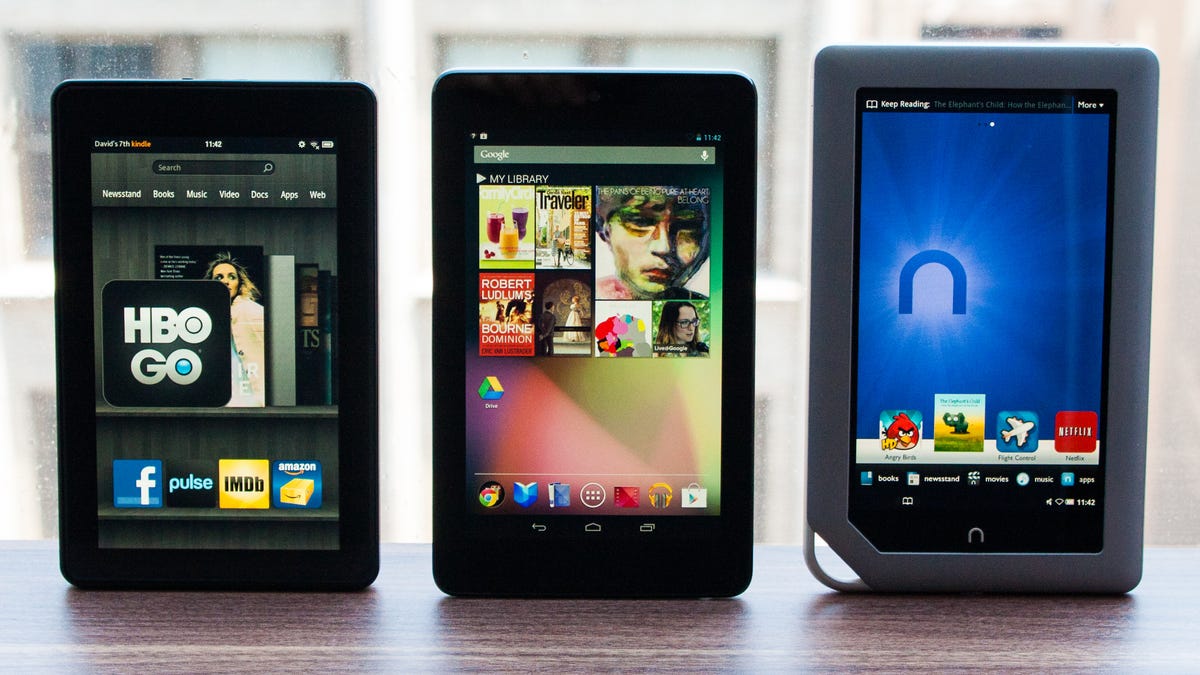Nexus 7 vs. Kindle Fire vs. Nook Tablet: Battle of the $199 tablets
With the launch of Google's Nexus 7, the $199 tablet market got even more crowded. So, is it the best?
Amazon opened a lot of eyes when it introduced the Kindle Fire last year at $199. Many people expected it to come out at $249, but Amazon surprised everybody with $199. Now Google's done the same with its Asus-made Nexus 7, which, on paper anyway, offers the best specs for a 7-inch tablet at its price point, besting its closest competitors, the Kindle Fire and the 8GB Nook Tablet (you could also include the Samsung Tab 2 7.0 in this group, but it starts at $250).
Of course, specs aren't everything, so before we declare the Nexus 7 the winner and new 7-inch champ, here's the quick skinny on the pros and cons of each tablet.
Kindle Fire
But the first-generation Kindle Fire is what we have right now, so let's take a look at its strengths and weaknesses.
Strengths: The Kindle Fire makes the most sense for Amazon Prime members (it costs $79 a year to be a member) who can stream an excellent selection of free video content. As a Prime member, you can also access free e-book loaners through Amazon's Kindle Lending Library, including titles such as "The Hunger Games" and the entire Harry Potter collection. In our review of the Fire, we also gave high marks to Amazon's user interface and we liked Amazon's App Store for Android. There are some definite advantages to living in and embracing Amazon's ecosystem.
Weaknesses: The Fire's design is fairly generic (it's basically a repurposed
Read CNET's review of the Kindle Fire.
Nook Tablet
Weaknesses: It doesn't have such features as Bluetooth, a front-facing camera, or GPS (it does have a built-in microphone), and its 1,024x600-pixel screen resolution doesn't match the 1,280x800-pixel resolution of the Nexus 7. The Nook Tablet isn't an open Android tablet like the Nexus 7, and -- again, like Amazon -- Barnes & Noble is running a heavily skinned version of Android on the tablet and you can't access Google's Play app store.
Read CNET's review of the Nook Tablet (8GB).
Nexus 7
Weaknesses: The Nexus 7's battery is slightly smaller (lower capacity) than the batteries in the Kindle Fire and Nook Tablet. That said, the base battery life of each device is very similar (around 8 hours of video playback). Also, there's no expandable memory option for the Nexus 7, which includes only 8GB of integrated memory, and the Google entertainment ecosystem (movies, music, and e-books) doesn't measure up to Amazon's -- both in terms of content and user interface. (That said, Amazon's Kindle e-book app and Cloud Music app go a long way to bringing a good deal of the Kindle Fire content offerings to the Nexus.)
The Nexus 7 by the numbers:
Read CNET's review of the Google Nexus 7.
Conclusion
It's not totally fair to compare a product that's just hit the market to products that have been on the market for eight months or so, but as I said, these are the current choices at $199, so you inevitably compare products.But while the Nexus 7 seems to be the clear winner in terms of features and performance and has certainly set the bar higher for what you can now get in a $199 tablet, you may consider holding out a bit to see what Amazon's answer is. I suspect that the new Kindle Fire 2 will have very similar specs and a slimmer, sleeker look that will match up well against the Nexus 7's design (Asus is making the Nexus 7 for Google. I doubt it would do the Kindle Fire 2 for Amazon, but we've seen stranger things happen in the consumer electronics world.)
As for Barnes & Noble's answer, I'm not sure, but it, too, is probably working on a new tablet that measures up to the Nexus in terms of features and specs.
And, of course, with rumors continuing to swirl that Apple might release its own 7-inch iPad this fall, you may want to wait on the Nexus 7 (that model would probably cost closer to $300 than $200 but plenty of people wouldn't mind).
If none of that concerns you, place your order. For the moment, anyway, the Nexus 7 is at the the top of the $199 tablet heap. Watch our First Look below.


